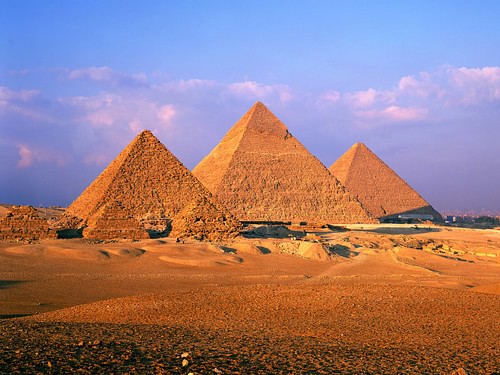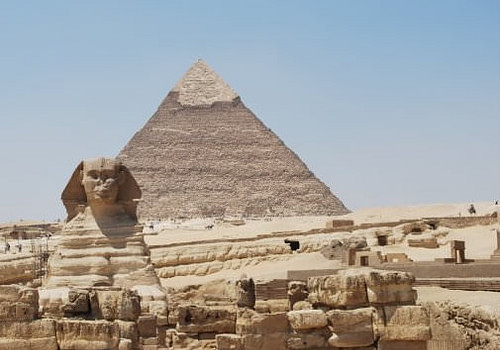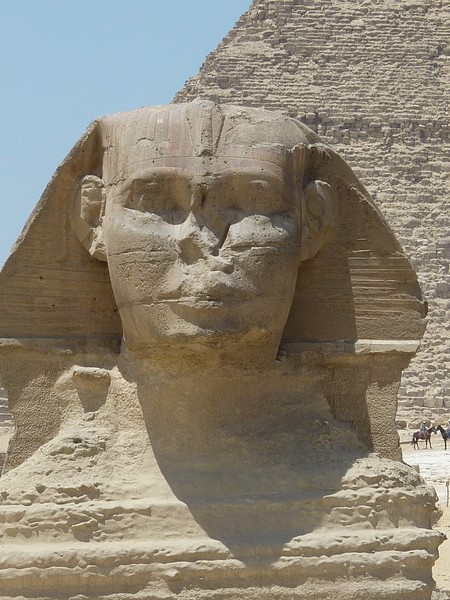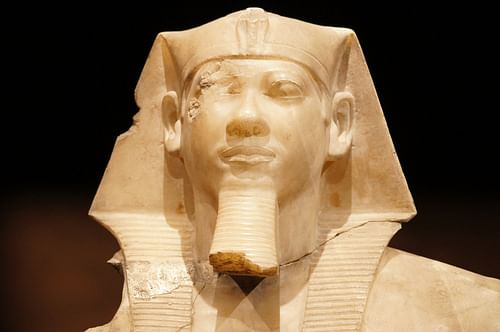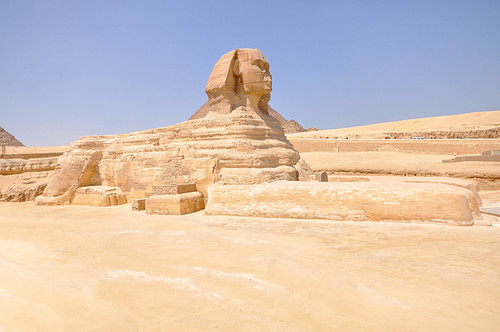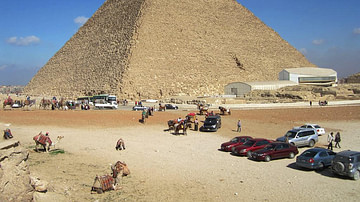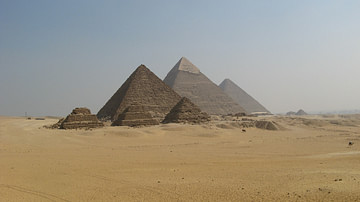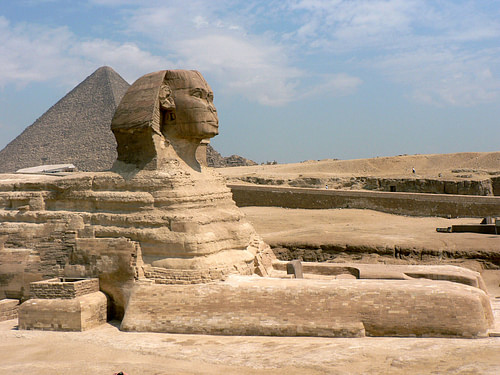
The Great Sphinx of Giza is the most instantly recognizable statue associated with ancient Egypt and among the most famous in the world. The sculpture, of a recumbent lion with the head of an Egyptian king, was carved out of limestone on the Giza plateau probably in the reign of the king Khafre (2558-2532 BCE) during the period of the Old Kingdom of Egypt (c. 2613-2181 BCE), although some scholars (notably Dobrev in 2004 CE) claim it was created by Djedefre (2566-2558 BCE), Khafre's brother who tried to usurp the throne after the death of the king Khufu (2589-2566 BCE), the creator of the Great Pyramid.
Other Egyptologists, and scholars, professors, and historians from outside the field, have claimed the Sphinx is much older than the 4th-Dynasty date mainstream Egyptology continually insists on. The claims of some of these writers, such as Zechariah Sitchin and Erich von Daniken, have long been discredited by scholarship in the field, and those of more recent writers on the subject are routinely ignored or claimed to be irrelevant or incorrect.
Scholars remain in disagreement over who had the Sphinx carved and when it was created, but all agree it is an impressive piece of work which, for centuries, was the largest sculpture in the world. The Sphinx measures 240 feet long (73 m) and stands 66 feet high (20 m), oriented on a straight west-to-east axis. The Egyptologist Miroslav Verner comments on the significance of the sculpture writing:
The Great Sphinx of Giza is more than simply a symbol of ancient and modern Egypt. It is the very embodiment of antiquity and mystery itself. Over the centuries it has fired the imaginations of poets and scientists, adventurers and travelers. Although it has often been measured, described, investigated using the most up-to-date scientific technical means, and discussed at special scientific conferences, fundamental questions remain unanswered: Who built it, when, and why? (234)
There have been many theories put forth in attempts to answer these questions, but few satisfy all three or are universally agreed on. It is commonly accepted among Egyptologists, however, that the Sphinx was built under the reign of Khafre during the Old Kingdom's 4th Dynasty when masons who were constructing his pyramid complex came upon a large piece of limestone and decided - or were directed - to carve the Sphinx from it. Why this was done and what purpose the Sphinx originally served is continually debated.
Name
The statue was never known as 'the sphinx' by the ancient Egyptians. The word 'sphinx' is Greek and came to be applied to the Egyptian sculpture at Giza, according to Verner (and others) through a translation of the Egyptian name shesep-ankh ("living image") by which the Egyptians referred to the piece as well as to other representations of royal figures. While that may be, it is also quite likely that the statue simply reminded Greek writers of their own mythical sphinx, such as the one famous in the story of Oedipus, with the body of a beast and head of a woman. Greek visitors to the site, scholars such as Verner claim, mistook the nemes (the striped headcloth of the king) for a woman's shoulder-length hair. 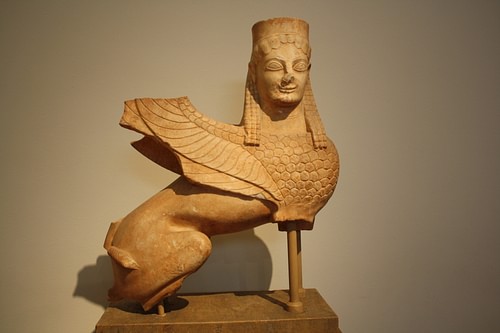
Amenhotep II's son, prince Thutmose, fell asleep one night near the Sphinx and had a dream in which the statue spoke to him complaining of its state and how the sand pressed upon it. The Sphinx offered Thutmose a deal: if he would agree to clear the sand away from the statue and restore it, he would become the next pharaoh of Egypt. The young prince took the deal, restored the Sphinx, and had the now-famous Dream Stele erected in front of it, carved of pink granite, to tell the story of how the prince became Thutmose IV, Pharaoh of Egypt (1400-1390 BCE). The cult of the Sphinx grew up after the reign of Thutmose IV, most likely in response to the Dream Stele which encouraged people to look upon the statue as a living deity able to influence the future.
The 4th-century CE Coptic Christians called the statue Bel-hit (The Guardian), and this name is still used today. Egyptians of the present day do not refer to the statue as 'the Sphinx' unless they are discussing it with foreign tourists. The piece is known in Egyptian Arabic as Abu al-Hawl, 'The Father of Terror,' and has been claimed to be an idolatrous abomination by some extreme factions of Islam. In 2012 CE, in fact, clerics associated with the taliban called for the destruction of the Sphinx and the pyramids of Giza for this reason.
Construction
The Giza plateau in antiquity was vastly different in appearance to how it is in the present day. Archaeologists and geologists working in the region have found evidence, through patterns of erosion, fossilized plant and animal material, and artifacts, that the area some 8,000 years ago was once quite fertile and lush with vegetation. Water was abundant and underground aquifers are still, as evidenced by the difficulties Zahi Hawass and his team had in exploring the Osiris Shaft of the Great Pyramid in 1999 CE due to the high water table. Rainfall was plentiful in the region c. 15,000 BCE, and though it became less so in time, the area was still quite fertile at the time of the 4th Dynasty.
The capital of Egypt during the Old Kingdom was the nearby city of Memphis; Giza was chosen as the necropolis for the kings of the 4th Dynasty, the great pyramid builders, because it had been used by rulers during the Early Dynastic Period of Egypt (c. 3150-2613 BCE) and possibly even the Predynastic Period (c. 6000-c. 3150 BCE). King Djoser (c. 2670 BCE) had already built his famous Step Pyramid and complex at Saqqara while, at Giza, there were only mastaba tombs. King Sneferu (c. 2613-2589 BCE) perfected the art of pyramid building through his work on the Meidum Pyramid, Bent Pyramid, and Red Pyramid. By the time King Khufu came to the throne in 2589 BCE Egyptians understood well how to work in stone and how to create monuments on a grand scale. Most likely Khufu chose Giza as the site for his Great Pyramid in order to showcase the work in the best setting and away from predecessor's creations.
Khafre succeeded Khufu and began his own pyramid complex next to his father's. The Sphinx is credited to him because the creature's face resembles his as it appears in statuary and because of the way in which the Sphinx seems to have been carved. The theory goes that, in the process of building Khafre's pyramid, workers uncovered a large mass of rock considered unsuitable for the pyramid complex and carved the statue from it. Historians Bob Brier and Hoyt Hobbs comment on this:
Khafre's pyramid [was faced with a] gleaming casing of white limestone, transported by boats from quarries across the Nile [and] laid over interior limestone blocks which were cut from the surrounding Giza site. Probably in the course of freeing these interior blocks, quarrymen struck a seam of harder rock they avoided, leaving a small hill. Khafre had the outcrop carved in the shape of a recumbent lion bearing his own face - the famous Sphinx. (16)
The Sphinx is directly in line with Khafre's pyramid complex and this also supports the claim that he was its creator. The location of the statue, however, and how it lines up with Khafre's complex, has led some scholars (such as Stadelmann of the German Archaeological Institute of Cairo) to believe that the Sphinx already existed when Khafre came to the throne and his complex was purposefully designed to line up with the sculpture. The famous English Egyptologist E. Wallis Budge (1857-1934 CE) claimed that the Sphinx was much older than Khafre's time and could have been created in the Early Dynastic Period or even earlier. Dobrev, as noted, claimed in 2004 that the statue was completed by Khafre's brother Djedfre in honor of his father Khufu and that the face of the statue resembles Khufu's far more than Khafre's. Dobrev also agrees with Stadelmann that Khafre's complex was oriented to the Sphinx rather than the statue being carved during or shortly after construction.
Certain evidence, however, strongly argues for construction during Khafre's reign. The face of the creature aside, it is positively known that the limestone which constitutes the Sphinx is the same as that used in Khafre's pyramid. The kind of technical skill evidenced in the creation of the Sphinx can be seen in statues of Khafre and statuary of the gods from this time in the Old Kingdom. The orientation of Khafre's complex strongly suggests that it was built with Khufu's pyramid and complex in mind, not the statue, and that the Sphinx was created during or shortly after his pyramid.
Further evidence that the Sphinx was created after the pyramids comes from an inscription on the left paw of the statue dating to 166 CE. The inscription commemorates a restoration project by the Romans of the walls which surrounded the statue at that time. The inscription was first discovered in 1817 by Caviglia (1770-1845 CE) in his excavations at Giza and was translated and published by the English polymath and occasional rival of Champollion, Thomas Young (1773-1829 CE), in the Quarterly Review, Volume 19 of 1818 CE. Although this inscription does not verify any given date of construction it does suggest that, during the period of Roman Egypt, the statue was understood to be younger than the pyramids as it states how the creators of the monument "near the pyramids have bid thee stand" and how the purpose of the Sphinx was to watch over the "beloved prince" buried nearby (Leitch, 200). The inscription could be interpreted, however, to mean the Sphinx watches over the present monarch of Egypt in 166 CE - the Roman Emperor - and the earlier line merely a poetic way of saying the Sphinx was located near the pyramids at that time. The inscription can be read either way and, further, is missing some lines near the end. Still, those who accept the orthodox dating of the statue to the 4th Dynasty point to the inscription as a later proof of their claim.
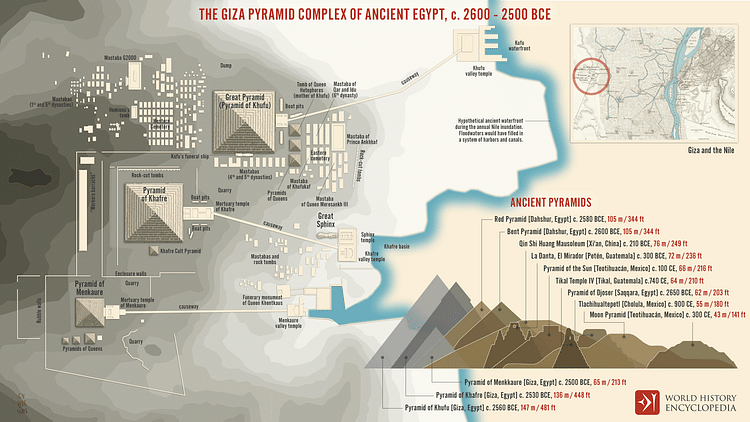
Controversy & Dissent
Even so, the Sphinx defies such an easy and comfortable placement in time. Human beings, all protests to the contrary, cannot tolerate a mystery. Mysteries are only intriguing if they conclude with clarity of resolution; the Sphinx offers no such clear-cut conclusion.
In 1858 CE the archaeologist Auguste Mariette (1821-1881 CE) discovered the inscriptions now known as the Inventory Stele near the pyramid of Khufu. This stele lists 22 statues of The Temple of Isis at Giza and very clearly states that Khufu erected a monument near the Sphinx; therefore the statue must have existed prior to the rule of Khufu and so earlier than Khafre. If the Inventory Stele dated from the 4th Dynasty, it would indeed be compelling evidence that the Sphinx pre-existed the reigns of Khufu and Khafre; but it does not. The Inventory Stele has been positively dated to the 26th Dynasty of the Third Intermediate Period of Egypt (c. 1069-525 BCE). The Egyptians at this time regularly invoked the names of earlier kings, especially the pyramid builders, in an effort to recall the glory of the past. It seems clear that whoever carved the Inventory Stele was purposefully trying to elevate the status of the Temple of Isis by making it appear older than it actually was in dating it to the time of the great Khufu. Actually, the ruins of the Temple of Isis at Giza date to the Middle Kingdom (2040-1782 BCE) long after Khufu's reign.
A more significant argument for the earlier construction of the monument is that, although archaeologists have found inscriptions and evidence relating to the construction of the pyramids of Giza in the 4th Dynasty, how the workers were housed, what they ate, how they were paid, there is never any mention of the Sphinx. This fact is especially significant when one considers how carefully the Egyptians documented building projects. Even if one were to claim - as some have - that such evidence simply has not yet come to light, it still seems odd that so large and obviously significant a structure would not be mentioned anywhere by anyone at the time it was supposedly built.
Another argument against the Sphinx being built by Khafre is that the face is not his. Dobrev asserted in 2004 CE that the face was not Khafre's, but geologist Dr. Robert M. Schoch had already claimed that not only was the face not Khafre's but the Sphinx itself was much older than Khafre's reign. Schoch and Egyptologist John Anthony West hired forensic specialist Frank Domingo, with over twenty years of experience in the New York Police Department sketching suspects and creating facial reconstructions, to examine the Sphinx and Khafre's statue and determine if they bore the same face. Domingo's conclusion, after an exhaustive study of both works, was that they represented two different people. Schoch further claims that the present face is not that of a man but a woman.
Schoch and West both contend that the Sphinx is centuries older than mainstream Egyptology claims it is. Schoch, a geologist from Boston University, has famously noted that the erosion marks on the Sphinx suggest extensive rainfall over a very long period. This kind of weather pattern was not evident at the time of the 4th Dynasty of Egypt, and so the statue is obviously older than that period. In answer to the challenge from mainstream Egyptology to show evidence of a culture predating the traditionally accepted time of Egyptian civilization, one which could have created a monument such as the Sphinx, Schoch and West point to the ancient site of Gobekli Tepe in modern day Turkey which dates back 10,000 years and is attributed to no known civilization. Sculpture found at Gobekli Tepe is as sophisticated as that of the Sphinx and sometimes more so.
Schoch and West contend, then, that the face is not Khafre's, the dating of the sculpture is completely wrong, and all assertions made based upon such dating need to be revised. They are countered by Egyptologists such as Mark Lehner who point to the similarities between the face of the Sphinx and Khafre's statuary and how the erosion patterns on the statue have nothing to do with its age; if such erosion took place on the Giza plateau it would not be restricted to a single monument. This particular debate on the Sphinx is ongoing.
Writers Robert and Olivia Temple claim that not only is the face of the Sphinx not Khafre's, it is not even the original face of the statue. The head of the Sphinx is notably out of proportion to the rest of the body; it is significantly smaller. The Temples argue that this is because the Sphinx was not carved in the 4th Dynasty under Khafre but centuries earlier and was not originally a lion but the jackal god Anubis. According to this theory, the great statue was Anubis who traditionally guarded over a necropolis and such a statue would certainly fit the location the Sphinx occupies at Giza.
In the 4th century, the Temples claim, the statue was re-carved to depict a lion with a king's head because the lion was a popular figure in zoolatry (the worship of animals) at the time. The kind of anthropomorphism the Sphinx represents was clearly established by the 4th Dynasty but it is unclear how far back in Egyptian civilization it was observed or how it developed. Egyptologist Rosalie David notes how "there are no extant literary sources which throw light on either the predynastic practice of zoolatry or anthropomorphism which occurred c. 3000-c. 2800 BCE. We can only speculate about the reasons for these developments" (53). David comments further on depictions of the gods in general and the Sphinx in particular, writing:
The forms and dress of the gods were always shown in a fairly uniform manner, providing no indication of the historical date of the figure; the god's individuality or particular function was represented by his distinctive headwear or animal head. A reversed example of the mixture of animal and human features occurs in later periods, in the form of the sphinx, where a human head is placed on an animal body. Whenever animal and human features were united in one body, any details which might appear ludicrous or grotesque, such as the place where the head and the body joined, were masked: in this instance, the neck area was concealed with the lappets of the headdress. (53)
The Temples would disagree with this assessment as they claim the head of the Sphinx was re-carved and thereby diminished from the larger head of Anubis. The lappets of the headdress would then not have been utilized to conceal the neck area but simply to make use of the stone of the original head and also, of course, to remain in keeping with the depiction of an Egyptian king of the period. Robert Temple also claims that the face is not Khafre's but that of Amenemhat II (c. 1929-1895 BCE) based on the style of the stripes on the headcloth of the Sphinx which he says are distinctive of the 12th Dynasty of the Middle Kingdom. Among the reasons mainstream scholars reject these claims is that they are largely speculative. There is no evidence in any form that the Sphinx once had a different head and the difference in proportion between the head and the body of the Sphinx can be explained easily by the amount of stone the quarrymen had to work with and their process: the body of the Sphinx was carved first and the head last. The head was made smaller either because there was not enough stone or for greater stability.
Geologist Colin Reader refutes that argument by noting that the ancient Egyptians were masters in stonework and could not possibly have miscalculated in carving the Sphinx nor would they have shrunk the head out of proportion with the body for the sake of stability. There are plenty of other monuments, he notes, in perfect proportion, which have stood the test of time. Reader contends, along the lines of the Temples, that the Sphinx originally had a different head but claims it was a lioness, not Anubis. He supports his claim, in part, through a sphinx statue in the Cairo Museum which he interprets as having previously been that of a lioness which had its ears hacked off and face re-carved. Reader's primary contention, like that of others, is that there is no satisfactory explanation for the weathering of the Sphinx or the proportion of the head than that it predates the 4th Dynasty and was once a different monument.
Mainstream Egyptology refuses to consider any of these claims seriously - often for very good reasons - and dismisses them as 'pseudoscience.' Still, the claims continue to be advanced and the evidence the various authors present has not always been refuted, only ignored or ridiculed. Historian and Egyptologist Antoine Gigal argues in defense of these 'fringe' claims and further asserts that not only is the Sphinx centuries older than the accepted date but there were once two of them. Gigal cites the Dream Stele of Thutmose IV - which clearly shows two sphinxes - and the Inventory Stele which seems to indicate a second sphinx destroyed by a storm.
This second sphinx would have been located across the River Nile from the one at Giza. Two sphinxes would have certainly been in keeping with Egyptian art and architecture in that the ancient Egyptians greatly valued balance and observed the concept in all aspects of their civilization, often doubling municipal buildings and monuments (such as the practice of always raising two obelisks). Gigal also asserts that there were tunnels beneath these sphinxes which may have connected them. Tunnels have, in fact, been located beneath the Great Sphinx although it has been determined that they do not go anywhere.
Mainstream Egyptology bases its conclusions on precedent and evidence; those outside of the accepted view base theirs on the same precepts but lack the kind of training which allows Egyptologists to interpret artifacts within the framework of cultural context. Alternative views are regularly rejected if they do not appear to follow sound principles in arriving at their claims or disrupt the established narrative without sufficient evidence. In the case of the Sphinx, however, due diligence is often observed by some of those claiming the statue's alternate history and still their claims have been dismissed.
Mysteries & Myths of the Sphinx
The Great Sphinx of Giza is so well known today that one might assume it was equally famous in antiquity, but this is not so. There is little mention of the statue in Egyptian inscriptions. None of the materials unearthed at Giza or anywhere else in Egypt make any mention of the statue's construction; it is referenced as though it always existed when it is mentioned at all. Herodotus is silent on the Sphinx as are other early Greek writers. Pliny the Elder (23-79 CE) mentions the statue in his work on Natural History and claims it was revered as a god and also served as a tomb; no other ancient writer either confirms or contradicts his claim.
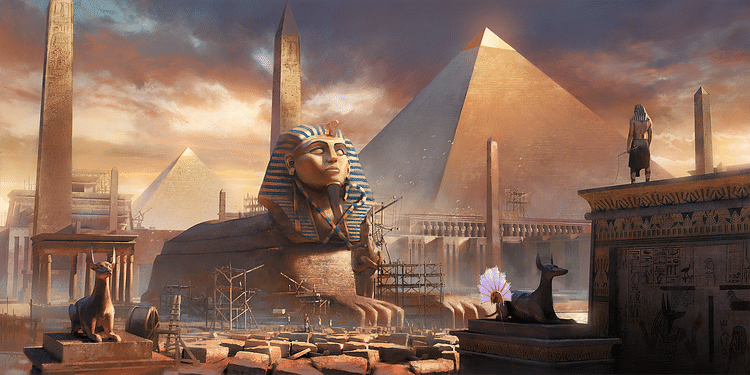
This same paradigm can be observed in myths concerning the Great Sphinx supported by so-called 'New Age' writers. These authors maintain that the statue has supernatural powers, that there are tunnels beneath it which connect to a subterranean network (as noted, there are tunnels under the Sphinx, but they lead nowhere) and many other 'fringe' theories, often involving extraterrestrials, which are regularly dismissed by mainstream scholars. Even though there seems to be no evidence, or weak evidence at best, to support these claims, individuals continue to maintain the 'New Age' narrative because it supports and encourages their beliefs about the world and universe in general. Once an individual becomes comfortable with a certain belief system - whether the orthodoxy of one's field of study or anything else - one is unlikely to exchange that belief for another. This paradigm extends also to theories regarding the destruction of the nose of the Sphinx.
Writers regularly repeat the absolute falsity that Napoleon's troops shot off the nose on their campaign to Egypt in 1798-1801 CE. The French artist Frederic Luis Norden's drawing of the Sphinx from 1737 CE shows the Sphinx's nose already destroyed and the draftsman Dominique Vivant Denon (1747-1825 CE) who accompanied Napoleon on his campaign shows the same. The nose could have been damaged in the Arab Invasion of the 7th century CE, as some have claimed, or by a Muslim cleric of the 14th century CE who was enraged at finding Egyptian peasants still venerating the statue as a deity. Although these possibilities are regularly mentioned, the story of Napoleon's troops using the Sphinx for target practice continues to appear in books, documentaries, and articles uncritically because it has become part of the narrative of the Sphinx's history: an invading force, unable to appreciate the grandeur of an ancient monument, vandalizes it. In reality, Napoleon admired the ancient works of Egypt and brought scientists, artists, and engineers with him to study and record the monuments, not destroy them.
Whatever its origins and original purpose, Verner is correct when he says how the Great Sphinx of Giza is "the very embodiment of antiquity and of mystery itself" (234). A giant recumbent lion with the head of a man sitting in the midst of an ancient plateau begs to have a reason given for it and a history commensurate with the fascination it has inspired over the centuries. The Sphinx lives up to its name in that it is a riddle whose very presence frustrates attempts to give a satisfying answer. Even if all the alternative histories of the monument were accepted, there would still be others proposing alternatives to those alternatives. As with any great work of art, the Sphinx leaves itself open to interpretation, but unlike most, this struggle with interpretation goes beyond the work itself and, unless one accepts the conventional view, leads to more questions than answers.
